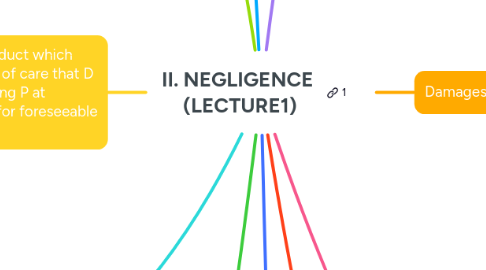
1. Standard of Care
2. Causation
2.1. 1. Actual Cause
2.1.1. D's N was "more likely than not" cause of Ps injury = "but for"
2.1.1.1. if more than one D, can't use; instead: 'substantial factor'
2.1.1.1.1. If 2 or more Ds acting jointly, ALL liable for total (J&S liability)
2.1.1.1.2. if 2 or more not acting jointly, each liable for amt. of N, if can allocate
2.1.1.1.3. if 2 or more acting independently, and N of either would have caused total dmg -- J&S liability
2.1.1.1.4. 2 acting independently, combined injury is greater than separate N of either independently. Then both are J&S liable for whole injury
2.1.1.1.5. 2 or more acting independently. P injured by one, not both. impossible to tell which one. both are J&S liable to P
2.2. 2. Proximate Cause
2.2.1. legal cause
2.2.1.1. Palsgraf
2.2.1.1.1. reasonably foreseeable harm; in the zone of danger. (horse - hurricane - A falls on B in pool, etc.) Could D reasonably see harm to all who were harmed.
2.2.2. Rules for multistate:
2.2.2.1. 1.was P within proximate cause? (Cardoza - reason'y foreseeable to D that P in Z of D0
2.2.2.1.1. rescuers ALWAYS foreseeable
2.2.2.1.2. pure econ, loss not recoverable
2.2.2.2. 2. was the harm w/in proximate cause? -- unbroken sequence of events; yes.
2.2.3. Intervening cause: even after D's tort causing add'l harm to P. Is P liable?
2.2.3.1. Yes, IF intervening cause reasonably foreseeable. "superceedng cause"
2.2.3.1.1. UN foreseeable cuts off liability
2.2.3.2. usu, intentional torts or criminal act is UNforeseeable and D not liable.
2.2.3.2.1. BUT: if intervening event not foreseeable, D may be liable for dmgs if risk created by D was foreseeable
2.2.3.3. modern: D liable for suicide of one harmed by D's negligence
3. Liability for Acts of Others
3.1. Vicarious Liability
3.2. vicarious liability
3.2.1. Principal and agent
3.2.1.1. partners and partnerships
3.2.1.1.1. W,W,W,W -- J&S liability
3.2.1.1.2. Joint enterprise - all liable
3.2.2. independent contractors - except for nuisance, inherently dangerous activity, non-delegable duties
3.2.3. master liable for servant if T committed during scope of employment: What, Where, When, Why
3.2.3.1. commuting to and from work NOT "w.in scope of employment"
3.2.4. borrowed servant - who was controlling details of wk at time of T
3.2.5. Servant is ALSO liable, in addition to master. indemnification applies.
3.2.5.1. also for intentional T ala w/in scope of employment
3.2.6. Automobiles: owner not liable for N of driver
3.2.6.1. Except: Family Purpose: O liable if fly member driving for fly purpose. Social, not business
3.2.6.2. Negligent entrustment
3.2.6.2.1. you N'y entrusted someone when you shouldn't have
4. Defenses
5. "negligence is conduct which breaches the duty of care that D owed to P by placing P at unreasonable risk for foreseeable harm"
5.1. prove N by 1. Direct E; 2. viol. of statute; 3. circumstantial E (RIL) :)
6. Negligence Per Se
7. Initial Assessment: 1. was there a duty? 2. was there breach of duty? 3. was there causation - P injured b/c D's breach = actual cause? 4. proximate causation? 5. dmgs? 6. defenses?
7.1. no duty to render aid
7.1.1. unless special relationship - hotel/guest, parent/child; common carrier, school, host, employer/employee, etc.
7.1.1.1. even if harm caused by 3rd party
7.1.2. unless A caused the injury to B, A duty to aid
7.1.3. hospital
7.1.4. contract can create a duty
7.1.5. when D acts (harmless at first) but then something changes, invoking a duty to help. [loan car, learn brakes are bad. duty to tell]
7.1.6. if no duty but begin, then duty to continue and use RC = good samaritan rule
7.2. Breach of duty
7.2.1. Prove by Direct E of N
7.2.1.1. driving too fast, bad breaks, etc [reasonableness]
7.2.1.1.1. E of subsequent repair NOT admissible to prove N, yes for control/ownership
7.2.2. by Circumstantial E of N (Res ipsa loquitor)
7.2.2.1. rat tail in candy
7.2.2.1.1. rule of E; inference from facts
7.2.2.2. 1. occurs ordinarily only if someone is N
7.2.2.3. 2. it is THIS D, not someone else
7.2.3. by Viol. of statute
7.2.3.1. N per se; [some states "some E"]
7.2.3.1.1. 1. viol. must be unexcused
7.2.3.1.2. 2. harm must be type statute designed to protect
7.2.3.1.3. 3. P is member of class statute aimed at protecting
7.2.3.1.4. violation of licensing statute not relevant to N, nor is compliance E of RC (it is SOME E, but not conclusive
7.2.4. by Custom and Trade
